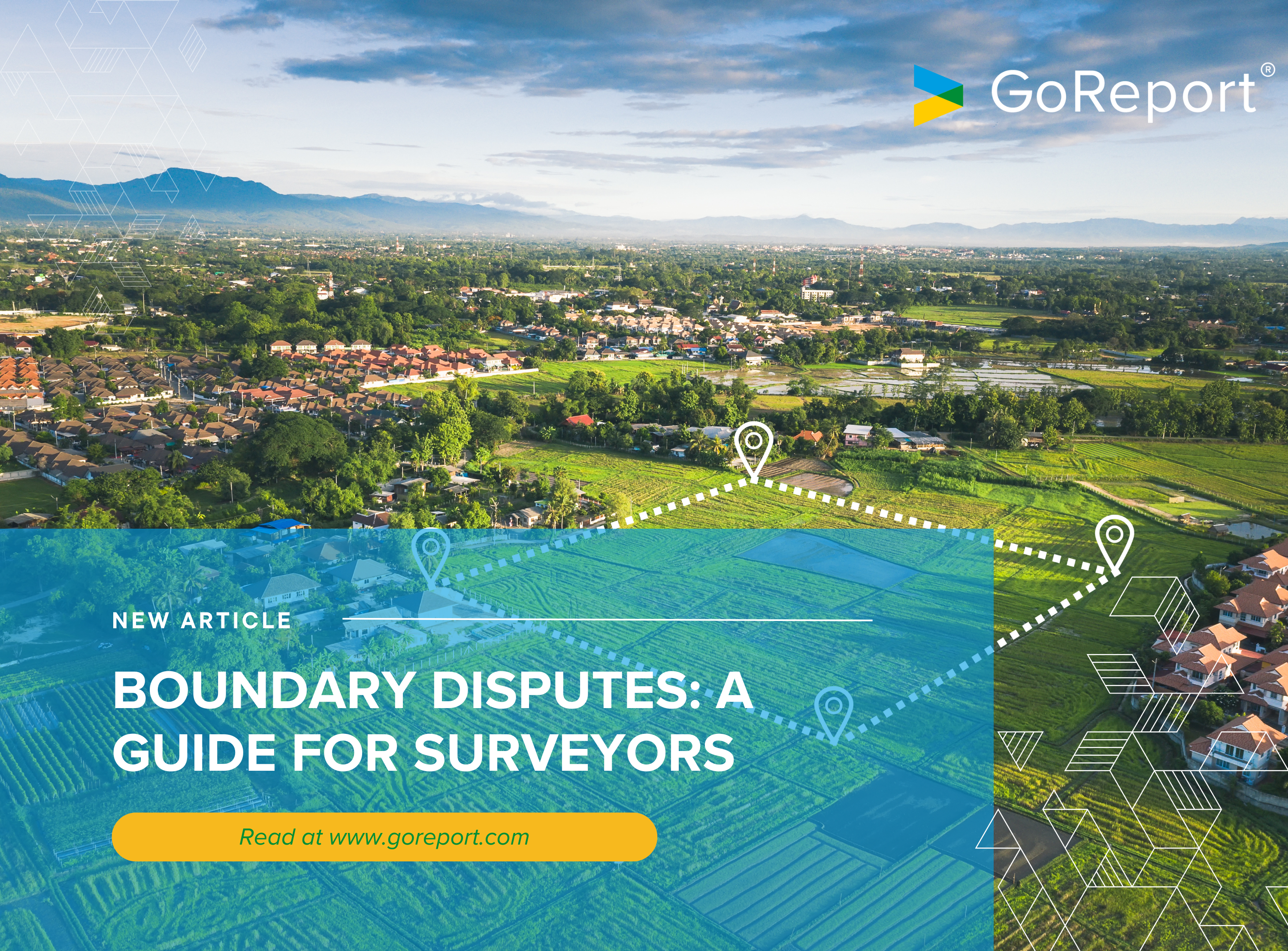Boundary Disputes: A Guide for Surveyors

Boundary disputes can be tricky, not to mention tension-inducing, often turning into long-running battles between neighbours. As a surveyor, you’re in a prime position to help bring clarity and prevent things from escalating into expensive legalfights, although this is often easier said than done. Whether it’s unclear deeds, old maps that don’t quite match up, or a fence that’s wandered onto the wrong side of the line, your expertise is key to bringing some resolution to ongoing disputes. From conducting precise surveys to working with legal teams, this guide will walk you through everything you need to know so you can handle boundary disputes with confidence.
What is a Boundary Dispute?
A boundary dispute happens when two or more property owners disagree on where one property ends and the other begins. This can be due to vague legal descriptions, fences or buildings creeping over property lines, or misunderstandings about long-standing land use. Your job as a surveyor is to step in, untangle the mess, and provide a clear, fact-based resolution to resolve conflicts.
The Role of a Surveyor in Boundary Disputes
Surveyors are the go-to experts for defining property boundaries, providing unbiased evidence, and ensuring any disagreements are resolved based on accurate data, such as historical records and precise measurements. Your work can help clients avoid costly court battles by offering precise measurements and professional assessments that can hold up in mediation or legal proceedings. Therefore, surveyors must maintain impartiality and ensure their reports are comprehensive, well-documented, and legally sound.
Common Causes of Boundary Disputes
Boundary disputes can arise for a variety of reasons, including:
- Unclear deeds: Some property descriptions are vague or outdated, leading to confusion and misinterpretations.
- Encroachments: Fences, sheds, or even extensions that cross over boundary lines.
- Adverse possession: When someone claims land based on continuous use over a period of time.
- Land use changes: Shared driveways, pathways, or new developments causing disputes.
- Survey mismatches: Differences between old and new measurements can create conflicts.
Whatever the cause, understanding these common issues can help surveyors anticipate and address potential disputes effectively.
The Average Cost of a Boundary Dispute in the UK
Boundary disputes aren’t just stressful for all parties involved, they can be expensive. On average, resolving one can cost between £4,000 and £12,000 in surveyor and legal fees. If it ends up in court, costs can exceed £20,000. Mediation is often a cheaper and less confrontational alternative where possible.
How Surveyors Assess Boundary Lines
Accurate boundary assessments rely on a combination of historical documents and modern technology. Some key methods include:
- Title deeds: Checking registered property documents for descriptions of boundary lines.
- Ordnance Survey maps: Comparing current boundaries to historical records.
- Physical markers: Identifying fences, walls, or natural features that define property limits.
- GPS and total station surveys: Using advanced equipment to pinpoint exact boundary positions.
By combining these methods, surveyors can provide a thorough and legally sound assessment of property boundaries.
Understanding the Boundary Disputes Protocol
The Boundary Disputes Protocol outlines a structured, straight-forward approach to resolving disputes before taking legal action. It encourages:
- Early intervention: Getting a surveyor involved as soon as a dispute arises.
- Sharing evidence: Ensuring all parties exchange relevant documents and reports.
- Mediation: Seeking a resolution through discussion before considering legal proceedings.
- Formal legal steps: As a last resort, disputes may go to court, where surveyor evidence plays a key role.
Following this protocol helps ensure disputes are resolved in the most efficient and cost-effective manner possible. It’s important for a surveyor to step in as soon as possible to come to a possible remediation backed up by legal documents and expertise.
What Legal Documents Should Surveyors Check?
When handling a boundary dispute, checking the right legal documents is crucial to ensuring the outcome is fair. These include:
- Title deeds: To establish the official boundary.
- Land Registry Plans: To verify any discrepancies between registered records and on-site measurements.
- Historical conveyances: To see if past agreements altered the original boundary.
- Easements and rights of way: To clarify any shared land use or access rights.
- Planning permissions: To check if past developments legally altered property lines.
A careful review of these documents ensures that boundary assessments are based on accurate legal foundations rather than guesswork.
Conducting an Accurate Land Survey
A solid boundary survey is essential for resolving disputes. Best practices include:
- Using high-precision tools: GPS, total stations, drones, and laser scanners ensure accuracy.
- Verifying physical boundary markers: Checking fences, walls, and old boundary stones against legal records.
- Comparing historical and current data: Spotting any inconsistencies in past and present maps.
- Taking natural and built features into account: Trees, waterways, and man-made structures can influence boundaries.
- Creating clear, well-documented reports: Including annotated maps and supporting documents for easy reference.
Surveyors who follow these best practices can provide accurate and legally sound boundary reports that will stand up in court.
How to Communicate Findings to Clients
Boundary disputes can be emotional for clients, so clear communication is key. Here’s how to make your findings easy for clients to understand:
- Keep reports simple and jargon-free: Clients aren’t surveyors, so avoid overly technical language and ensure technical due diligence.
- Use clear visuals: Diagrams, maps, and annotated photos help illustrate findings.
- Explain next steps: Outline the potential outcomes and options for resolution.
- Stay neutral: Your job is to provide facts, not take sides.
- Prepare for mediation or legal action: Your reports should be court-ready in case the dispute escalates.
Helping clients understand the facts in a straightforward way can prevent unnecessary conflict and lead to faster resolutions.
Key Steps for Surveyors to Resolve Border Disputes
To help settle boundary disputes, follow these steps:
- Clarify the legal boundary and your findings: Referencing title deeds, maps, and historical records.
- Engage both parties: Keeping communication open to prevent unnecessary conflict.
- Recommend mediation: Encouraging resolution outside of court to save time and money.
- Provide expert testimony if needed: If the case goes to court, your report will be key evidence.
- Follow the Boundary Disputes Protocol: Ensuring the process is fair and legally sound.
These actions can assist surveyors in resolving conflicts in a timely and professional way, ensuring all parties are aware of the next steps.
Working with Legal Experts and Mediators
Boundary disputes don’t always have to end in a legal battle, and that’s where legal experts and mediators come in. As a surveyor, you’re not just dealing with maps and measurements – you’re also helping clients navigate what can be a stressful and confusing situation. Understanding how legal professionals approach disputes can make your job easier and ensure your findings hold up in negotiations or court if needed.
Mediators can play a key role in settling disputes without the need for expensive legal action. They facilitate discussions between neighbours to help them reach a fair agreement. Your expert report will often be a crucial part of these talks, helping both parties understand exactly where the boundary lies. Mediation is usually much quicker and cheaper than taking a dispute to court, making it an attractive option for clients who just want a resolution without a lengthy legal process.
However, if mediation doesn’t work and the dispute escalates to legal proceedings, your role becomes even more important. A well-documented, impartial report can make all the difference in court. Legal teams will rely on your expertise to clarify boundary positions and support their case with factual evidence. Having a strong understanding of property law and legal processes means you’ll be better prepared to present your findings effectively.
Working closely with mediators and legal professionals allows surveyors to help clients resolve disputes as smoothly as possible. Whether it’s providing clear reports, assisting in negotiations, or even giving expert testimony, your role is key in making sure boundary issues are dealt with fairly and efficiently.
FAQ
Is there a time limit on boundary disputes?
Yes. Under the Limitation Act 1980, adverse possession claims typically require 12 years of continuous occupation (or 10 years if the land is registered).
Can a surveyor’s report resolve a boundary dispute?
It can provide crucial evidence, but mediation or legal action is often required for a final resolution.
What happens if neighbours refuse to accept a surveyor’s findings?
If one party disagrees, mediation should be the next step. If that fails, the dispute may need to be settled in court.
How can surveyors help prevent boundary disputes?
By ensuring property boundaries are well-documented, physically marked, and agreed upon in writing.
By following these best practices, surveyors can help property owners avoid disputes and resolve conflicts efficiently, saving time, stress, and money in the long run.








